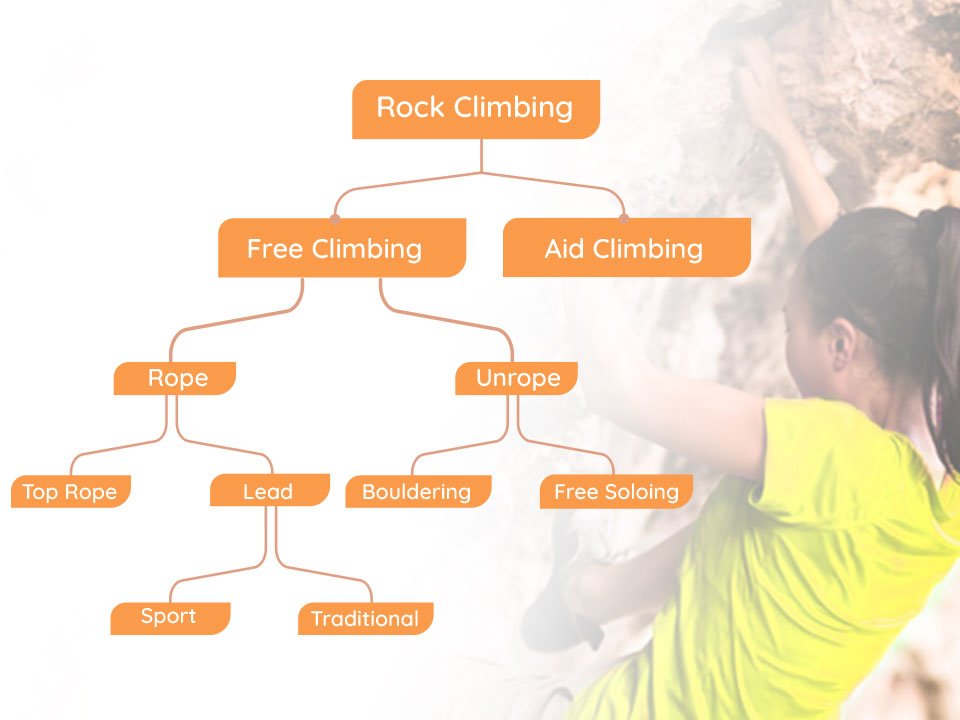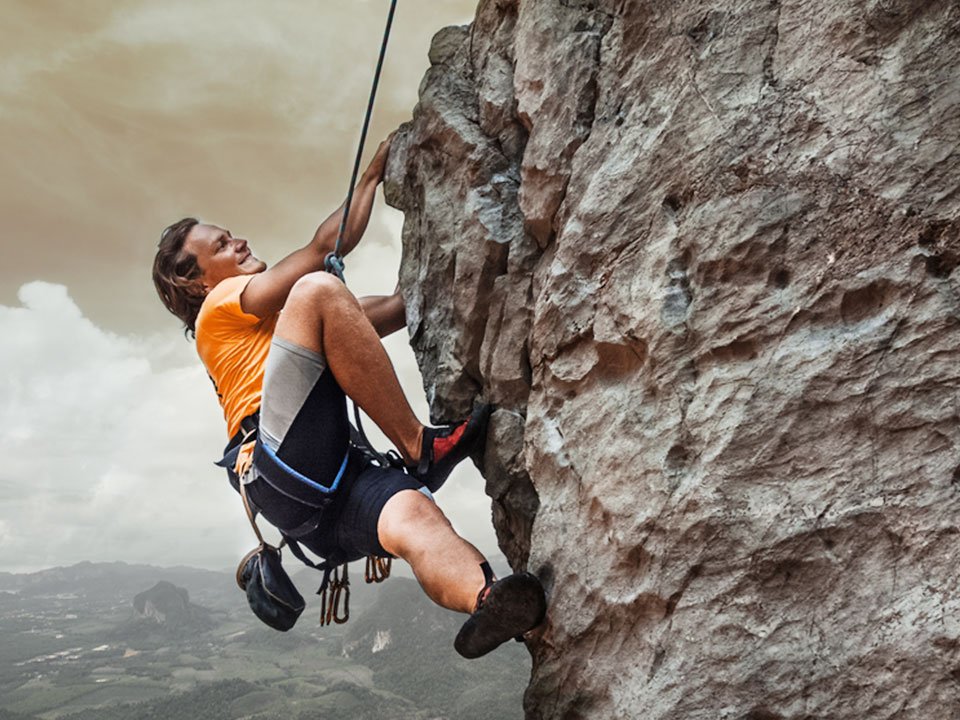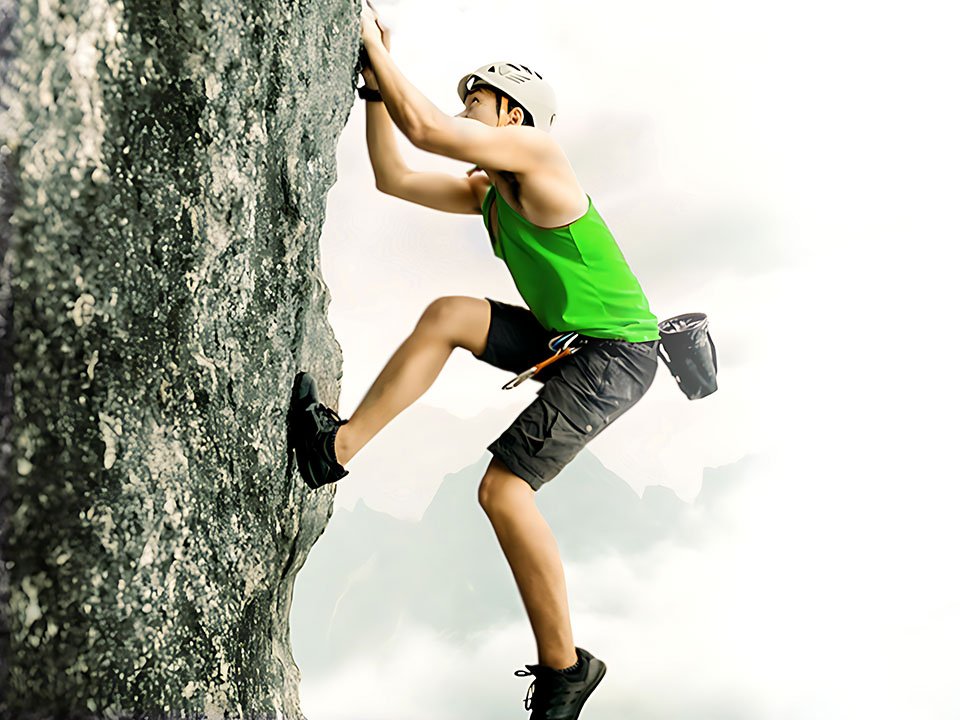You are climbing on the peak of a mountain during sunset…. Isn’t it thrilling and amazing at the same time? I can barely control myself from visualizing the realistic scenario and the vibe of the surroundings.
Almost everyone is familiar with the word rock climbing. It is a technique of climbing rocks where one climbs the rocks (outdoors or indoors) to reach the endpoint of a mountain without falling. Though rock climbing seems hard and risky, once you get accustomed to it, you will learn how to boost your health, community, strength, confidence, friendship, persistence, life goals, and many more. It is a good method of working out to burn fat. Also, rock climbing will make you physically and mentally fit. Surely you will have a good experience in rock climbing as long as you are up to date in using gears and techniques.
Before you start climbing, knowing the types and ways of rock climbing is a must. Over the past three centuries, different rock climbing categories have emerged. There are mainly two types of rock climbing. They are – free climbing and aid climbing. Later we will get to know all the subcategories in our next topic.
Key Takeaways
- To begin, aid and free- are the two types of rock climbing we are going to discuss here. Under these two, there are subcategories such as roped climbing, unroped climbing, lead climbing, sport climbing, bouldering, etc. Some other kinds of rock climbing are- big wall climbing, mixed climbing, deep water soloing, speed climbing, and so on.
- Ready to climb! Before climbing, select the stuff that you need, choose your place, and fix your partner or community. Later, you will get to know all of these in detail.
- Again, I have shared a few climbing safety techniques respectively so that one might get prepared himself before starting the journey.
Different Types of Rock Climbing
You may wonder as a beginner how to start and from where to start! First, choose the way you want to rock climb. Well, in that case, there are many types of rock climbing categories that you can follow.
Two major types of rock climbing and their subcategories are given below:
- Aid climbing
- Free climbing
Aid climbing and free climbing both contrast each other according to their methods. Again, free climbing has subcategories which we will discuss here also. Let me explain what is aid climbing and free climbing. And later I will give a summary of free climbing subcategories.

Aid Climbing

Aid climbing consists of different aids such as portaledge, fifi hooks, daisy chains, step ladders, haul bags, etc. Before free climbing, this method was followed by the climbers to ascend the mountain. Climbers also use these aiders during other forms of climbing like sport climbing and trad (traditional) climbing. Most climbers use removable protections such as nuts, hexes, chocks, etc. This practice is called ‘clean aid’. Aid climbing is easier than free climbing as you have gotten to know already that how it works.
Added to this, another learning fact about aid climbing is the range of the grades that define the necessity of safety and protection. There are two grades- one is an ‘A’ grade, and another is a ‘C’ grade. A1 to A5 determines the safety level; for example- A1 is super safe, and A5 is super dangerous. Again, the status ‘C’ confirms whether one can climb without a hammer.
Aid climbing is still effective for those who do not want to try free climbing at all. Just make sure that you are carrying your protection accordingly.
See Also: Do You Wear Socks with Climbing Shoes?
Free Climbing

Free climbing has become the mainstream of climbing. In this way, one has to climb up the mountain using their hand and feet only. Although climbers may use various kinds of gears to save themselves from falling but not move upwards.
Free climbing might sound troublesome due to its unique technique. One may get several injuries in their hands, wrists, knees, and other body parts as well. But if you are well-trained to handle the hazards then it might get easier for you to climb.
Now we will explain the sub-categories of free climbing here-
Roped Climbing
This method is nothing but tying a rope to climb while ascending toward the peak of a mountain. You have to climb through a vertical rope to reach your destination.
Lead climbing and Top rope- these two are the subcategories under roped climbing:

a) Lead Climbing
The word ‘lead’ itself declares the style here. In this technique the lead will be taken by one person, wearing a harness connected to the other climbers, who will be following the lead climber.Here, the lead climber is the belayer who will take responsibility for other climber safety. As long as the lead climber is climbing, others will follow him. He will stop the rope when others or he wants to take a rest or stop.
- Sport climbing: As you have known already what is lead climbing, sport climbing is nothing but one of the types of lead climbing similar to it. Bolt, hanger, rope, helmet, chalk bag, quickdraws, anchor, etc. you need to get for sport climbing. One more thing to add, in 2020 sports climbing made its debut at the Summer Olympics placed in Tokyo, Japan.Also, in 2024 we will be able to watch another competition in Paris.
- Traditional climbing: Traditional climbing or trad climbing is a bit different than sport climbing. Here the climbers remove their gears once they complete the pitch. Unlike sport climbing, the climbers may not fix the safety gears correctly while ascending, for hardest climbing this might get risky also.
b) Top rope
Top rope is less risky than lead climbing. An ‘anchor’ is attached from top to bottom which is designed to catch a climber’s fall. A trained belayer will guide you from the bottom to reach the peak of the rock. Because of the short distance and a safety guide (belayer), there is a small chance that you will fall and get a severe injury. Again, this style is most effective during indoor climbing to enhance your climbing skills.
Unroped Climbing
Unroped climbing- sounds deadly, but it is not. Two types of unroped climbing- bouldering and free soloing we will discuss now. Before the discussion let me describe what it is. Unroped climbing is the opposite style of roped climbing where one has to climb the rock without a rope.

- Free soloing: Free soloing is one form of unroped climbing where you will be climbing the rock solo without a single gear. Your one and only companion would be your feet and hands. I know you might be thinking that how one can even step upwards without any safety equipment. The thing is, the climber needs to be bold enough to take such steps as you already can guess how threatening it could be if one falls! So, free soloing is only for those who have expertise in rope climbing. Another interesting part is, an American athlete named Alex Honnald became the first person to free solo EI Captain in Yosemite National Park. Thus, you can go for free soloing as well, but don’t forget! You need to practice a lot before taking such kind of fatal step.
- Bouldering: If you are thinking about trying something simple and safe at the same time, then I must say that bouldering is for you. Cause like other climbing techniques you do not need to use a rope which is a plus point. Also, you can practice is it indoors as well. Boulderers take help from other people like belayers and lead climbing, whom we call spotters. They guide the climber before falling on the padded mat. You must wonder why anyone needs a pad if they fall from a short height. The answer is, to save you from getting hurt. Thinking about practicing rock climbing without any partners and with few gears? Then this trending climbing method could be the best fit for you!
Other Types of Rock Climbing
Apart from the above rock climbing styles, there are other types of climbing that you can try at least once in your life. It mainly depends on your fascination and willingness. Some other kinds of rock climbing are- big wall climbing, mixed climbing, deep water soloing, speed climbing, multi-pitch climbing, and highballing. Make sure that you have researched and trained yourself properly before attempting any of those types.
Things You Need to Know Before Rock Climbing?
Ready to experience the diverse world of rocks and mother nature? No worries… we are here to guide you about the arrangements and planning you need to do before heading.
- Choose your place- At first, you need to fix a location where you will do rock climbing. Added to that you can do some study on finding the best climbing location from google. Also, you can go to the USA, France Italy, Greece, or Switzerland for rock climbing or else try indoor climbing which has becoming popular day by day.
- Stuff you need for rock climbing- Then comes the matter of arrangements. While you will be practicing rock climbing, it is confirmed that you will get familiar with the equipment that you will need during your rock climbing journey. The stuff you need for rock climbing is- nuts and cams, a chalk bag, a crashing pad, ropes, climbing shoes, a harness, and other specific climbing gear depending on what kind of climbing you are doing!
- Select your partner or community- Finally, decide with whom or which people you want to go. If you are okay with a specific community or group, then I think that will be a good idea also instead of going on a solo trip to enhance your socializing capability. Yet you can go for solo indoor climbing where newbies are welcomed by the whole community as well.
Climbing Safety and Techniques
You need to follow some safety techniques for climbing. Now I would like to narrow down some tips regarding this matter –
- ‘Healthy body and healthy mind’ – I hope you already understand what I meant. So, always have food- full of nutrition and liquids too at that time.
- ‘Rest, sleep and breathe’- these are a must during your journey because it might get tiring at some point. Though sleeping would be hard, so you can go for having naps while climbing.
- Another important part of rock climbing is to select your gear such as rope, helmet, crash pads, harness, knots, etc. After selection, you should know how to utilize them properly.
- Moreover, “Harness, rope, and knots”- these three gears are very crucial for a climber. Accurate positioning of your harness, using longer and stable rope, and tying your knots tightly- these are the basic rules one might follow.
- ‘Beware from falling while climbing’ – we should not take this seriously. Why? See, the more you will get hurt during your training period, the more you will get stronger (both mentally and physically)
- Try to participate in all the rock climbing events to increase your skills and community. The more you will get involved in climbing sports and culture, the more you will get to know!
- Be careful before choosing your instructor and partner. Remember climbing is not about only ascending, you have to put your mental strength at the same time.
- Don’t forget to have fun! Cause climbing rocks is not an empire at all that you have to conquer! It is challenging I know, but try to enjoy the journey of climbing as much as possible.
FAQs
Is rock climbing beginner friendly?
Well, it depends on the time and effort that one is investing. The more you practice the more you will be experienced. Initially, it might get fatal for the climber but gradually you will overcome that.
What is a good age to start rock climbing?
One can begin from five years old. Many sports events are there where you can participate according to your age limit. If anyone tries climbing after their 50s or 60s, they must consider their age and health conditions as well.
Is rock climbing good for your health?
Obviously climbing is good for your health until you get yourself injured. Once you will start, you will realize the uniqueness of this exercise and how much effective it is!
Should I practice rock climbing indoors or outdoors?
Though indoor sport is the safest way for all to try climbing, once you feel that you are ready to begin your journey then you should try outdoors. Honestly, there are no such limitations whether you practice indoors or outdoors.
Final Thoughts
We already got an idea about different types of rock climbing. So, no need to get confused before starting the thrilling adventure. Because it is totally up to you when you want to start rock climbing. Also, you can try indoor climbing to practice.
Though rock climbing is an old tradition which has begun in the 19th century, sometimes for sport or sometimes for pleasure. With time people have discovered various ways of climbing. Yes, it is challenging and enjoyable! Recently rock climbing sport made its debut at Olympic in 2020 Tokyo Olympics. So many enthusiasts have participated in that sport. Despite that, thousands of mountain lovers are there who cherish the idea of rock climbing and have been traveling the world to climb the peak of untouched mountains.
No need to mention, there is a huge industry of indoor gyms where you can easily learn to climb. The fun fact is, for rock climbing you do not need to look upon your age- from juniors to eldest, everyone can try this. Rock climbing is costly, time-consuming, and risky. But the advantages of climbing are- visiting unique places of the world, knowing socialization, and learning the exclusive way of physical exercise.




